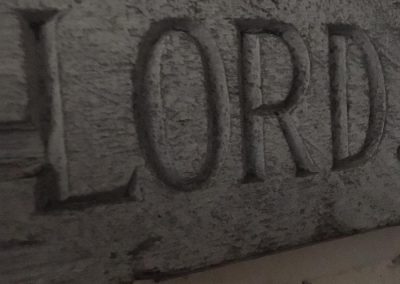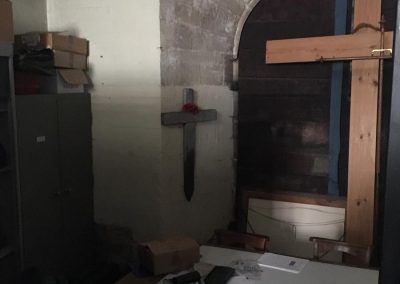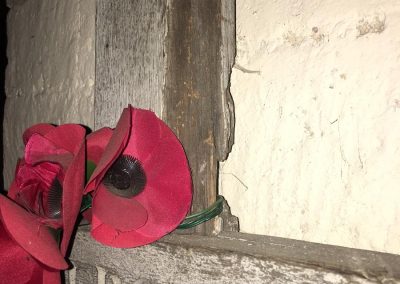Lord Charles Mercer-Nairne
We surveyed the two crosses in Calne, Wiltshire in October, and were very surprised to find both crosses related to the same man, Major Lord Charles Mercer-Nairne.
We unearthed some absolute historical gold evidence about one of these crosses. The first cross, located in St Mary’s, is the original battlefield grave marker. The second cross, on display in the chapel in Bowood House, is a much better made cross, unlikely to be a battlefield grave marker, more a symbol of commemoration for a family ripped apart by grief at the loss of their son.
We were extremely fortunate to receive the blessing of Lord Lansdowne, 9th Marquess of Lansdowne for our volunteer work supporting Returned from the Front; he also kindly facilitated our visit to Bowood. Lord Charles Mercer-Nairne is his grandfather.
Access to St Mary’s was very generously granted by the vicar’s wife, on her day off, who entrusted us enough on first meeting to give us her door key and allow us free access to the church, which is normally kept locked.
The photos taken within Bowood House were taken with the permission of the Bowood House staff, who agreed to their use in our report.
Please see the blog here

St Mary Calne Report
Location 1: St Mary the Virgin church, Calne, Wiltshire, SN11 0HU
Details on cross:
LORD. C. MERCER-NAIRNE
Text type: Carved.
Cross Dimensions:
Shaft Height: 1170mm
Cross Beam: 660mm
Width of Wood: 100mm
Thickness: 50mm
Other information:
Mounting to wall: hook screwed into rear of cross, twine tied through to nail in wall.
Detailing: None
Evidence of use in field: Yes. Sub-soil section is unpainted and has some mud on it.
Surface insertion depth: 480mm
Finish: Grey paint on cross above surface insertion level.
Condition: Overall, fairly good, although there is some damage at the top above the cross beam – possibly due to the wood being rotten? Evidence of old woodworm.
Further information
Please see blog
At Bowood House, in the chapel, there is a photograph of this cross in situ.
On the reverse of this photograph, is an original, contemporary 1914 piece of card, which contains handwritten instructions and a hand drawn diagram with measurements detailing the exact location of Lord Mercer-Nairne’s battlefield grave. All written in pencil. (Note the name at top left of the card shows Lord C Fitzmaurice. As the second son of the 5th Marquess, he was required by Scottish law to change his name to Mercer-Nairne in order to inherit a Scottish title and estate, but had been Petty-Fitzmaurice until the early 20th century).
More information:
Further to our completed surveys at Calne and Bowood House, in respect of Lord Charles Mercer-Nairne, we have had sight of the actual telegram received informing his parents of his death. The telegram was dated 31 Oct, and states:
“Deeply regret to inform you that Lord Charles Mercer Nairne Royal Dragoons has been killed in action yesterday. Lord Kitchener expresses his sympathy.”
Therefore, I feel we can safely assume the correct date of death is 30 Oct 1914, solving the matter of different dates showing on the plaque in St Mary’s church Calne, and the commemorative cross on display in Bowood House chapel.
The cross is situated in the north transept of the church, hidden in a curtained off area. There is a plaque on the wall, and a stained glass window in memorandum of Lord Mercer-Nairne. The area is dark and poorly lit.

Bowood House report
As mentioned on my earlier e-mail, this cross is not technically a battlefield grave marker, but for completeness, we have completed a survey for you.
The Bowood Estate was bought in 1754 by John Petty Fitzmaurice, 1st Earl of Shelburne (1706–1761); his descendants have lived here ever since. Not simply land owners, the Petty Fitzmaurices have served in public office almost continuously for over 200 years.
Bowood is a beautiful house with a rich history including the room where Joseph Priestley discovered Oxygen in 1774.
Capability Brown created the landscape gardens and stunning lake over 5 years between 1763 and 1768. It is one of the best (and most unspoilt) examples of his famous work.
The Lansdowne family were one of the first to pay the highest price of war, losing their son only 3 months into the war.
Location 2: Bowood House chapel, Calne, Wilts SN11 9PQ
Details on cross:
LORD CHARLES MERCER-NAIRNE
MAJOR 1ST ROYAL DRAGOONS
KILLED AT KLEIN ZILLEBEKE
OCTOBER 31ST 1914
Text type: Carved and painted black
Cross dimensions:
Shaft height: 1090mm
Cross Beam: 790mm
Width of wood: 150mm
Thickness: 70mm
Other information:
Mounting to wall: Ring loop from back of cross into screw in wall.
Detailing: None
Evidence of use in field: N/A
Surface insertion depth: N/A
Finish: highly polished and varnished
Condition: Immaculate
Further information:
During WWI, following the loss of their son, the 5th Marquis and Marchioness opened a Red Cross auxiliary hospital in the orangery of the house.
Bowood House held an exhibition in 2014 to commemorate WWI and the centenary of the death of Lord Mercer-Nairne.
A document produced by the Estate Archivist is included below, which includes much detail on Bowood House and Estate during the war and Lord Lansdowne and ‘the Lansdowne Letter’.
http://www.hha.org.uk/TrailPDF.ashx?pid=1028&trid=3
Survey research and photographs courtesy of Samantha Fryer & Alison Wilken
Date of survey: 17 Oct 16
























